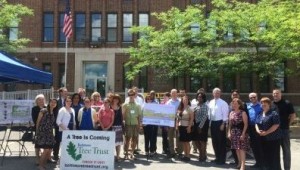by Tom Damm
Transforming lives is something Sarah’s Hope in Baltimore does every day as an emergency homeless shelter for families.
homeless shelter for families.
But this week, the focus at the safe haven was on a different type of transformation: replacing the asphalt and concrete on the property with an environmentally friendly community green space and outdoor playground area.
Earlier this week, EPA Regional Administrator Shawn M. Garvin was at Sarah’s Hope to join partners in announcing funding for a key phase of the project.
A $75,000 grant from the Green Streets, Green Jobs, Green Towns (G3) program will be used to tear up the hard surfaces in front of the property that during storms send rain water rushing into the street and drains, leading to flooding and pollution problems. The surfaces will be replaced with lawn, shade trees, native plants, and other green features that will let the rain soak in and provide a welcome lift to this troubled neighborhood.
The atmosphere at the event was upbeat as the project partners, Parks & People Foundation, the City of Baltimore and St. Vincent de Paul, described their plans for the facility.
The G3 grant will tie into a larger Baltimore City project to create public open space, a playground area and a community garden at the site, which is now almost fully covered with impervious surface. The work will improve the property for shelter residents and the community at large, and transform the appearance of the Sandtown-Winchester neighborhood.
Many of the other grantees were also on hand at the event to talk about how the G3 funds will help expand urban tree canopies, create bioretention cells to capture stormwater, and install other types of green infrastructure in neighborhoods in Maryland, Pennsylvania, and Virginia.
By keeping rain water from coming into contact with pollution in the first place, green infrastructure improves the health of our waters, while effectively reducing flooding, and helping our communities adapt to the very real challenges of climate change.
The G3 program – sponsored by EPA, and the Chesapeake Bay Trust, with assistance from the Maryland Department of Natural Resources – is in its fifth year. In this latest round of grants, 15 recipients will share in more than $727,000 in funding – bringing the total aggregate investment in G3 grants to more than $11 million when matching funds are included over the five-years that the program has been in existence.
About the Author: Tom Damm has been with EPA since 2002 and now serves as communications coordinator for the region’s Water Protection Division.
